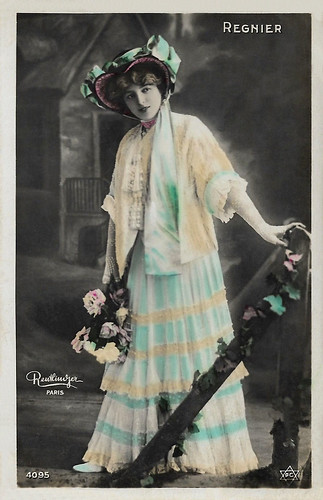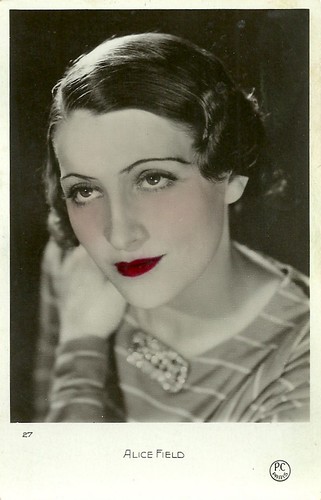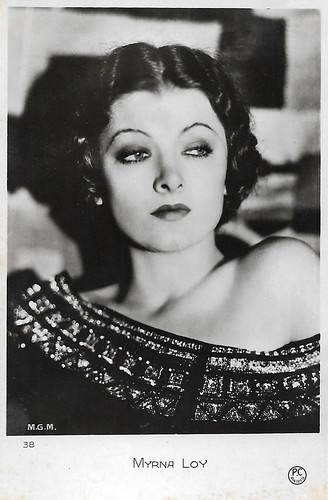The publishing house mainly published high-quality photographic postcards on a variety of subjects, including portraits of women in romantic settings, portraits of children, nudes, landscapes, Christmas cards and film star postcards. P.C., Paris was one of the first publishers to experiment with colour prints. Portraits painted by hand or with a stencil were on sale, and experiments with chemical dyes often gave the cards a different hue, using sepia, Prussian blue and red applied to a surface coated with silver grain. Also noteworthy was the pioneering technique of mixing orange, blue and green, which resulted in bright ‘psychedelic’ colour effects.

French postcard by P.C., no. 4095. Photo: Reutlinger, Paris.
Marthe Régnier (1880-1967) was a famous French stage actress and singer of the Belle Epoque and beyond. She also acted in six silent and sound films.

French postcard by P.C., no. 4095. Photo: Reutlinger, Paris.
Legendary actress Cécile Sorel (1873-1966) was the ‘queen of the French stage’ during the Belle Epoque, the period between the Paris Exposition of 1900 and the First World War. Her public appearances, often in extravagant costumes, created a sensation. During her long life, she played in five films.

French postcard by P.C., no. 4096. Photo: Reutlinger, Paris. Postcard mailed in 1909.
Amélie Diéterle (1871-1941) was one the most beloved actresses and singers of the Belle Epoque, who inspired poets and painters such as Mallarmé and Rodin. Between 1909 and 1913 she acted in some 25 short films at Pathé Frères, mostly Rigadin comedies directed by Georges Monca.

French postcard. P-C, Paris, no. 2. Photo: Paramount. Henri Garat sang the foxtrot 'Sur la terre' in Il est charmant (Louis Mercanton, 1932). Text by Albert Willemetz and music by René Mercier and Henri Forterre. Copyright: Editions Salabert, Paris, 1932.

French postcard by P-C, Paris, no. 8. Photo: Nalpas. Bach sang the song 'On n' m' a pas' (a 6/8 One-Step) in L'affaire Blaireau (Henry Wulschleger, 1932). Text by Ch. L. Pothier and René Pujol, and music by C. Oberfeld. Copyright: Editions Salabert, Paris, 1931.

French postcard by P-C, Paris, no. 16. Photo: Ufa. Lilian Harvey sings the Fox-Trot 'Je suis come ca' in La fille et le garcon (Roger Le Bon, Wilhelm Thiele, 1932), the alternate-language version of Zwei Herzen und ein Schlag (Wilhelm Thiele, 1932). Text by Jean Boyer, and music by Jean Gilbert. Copyright: Ufaton, Berlin / Ed. Salabert, Paris, 1932.

French postcard by Editions P-C, Paris, no. 19. Photo: Adolphe Osso / Gloria Film. Le Choer sang the military march 'Adieu, vieille Europe' in Le Sergent X/Sergeant X (Vladimir Strizhevsky, 1932), starring Ivan Mozzhukhin. Text by Simon Delyon and music by René Mercier and Henri Forterre. Copyright: Editions Salabert, Paris, 1932.

French postcard by Editions P-C, Paris, no. 32. Davia sang the foxtrot 'Je n'savais pas qu'c'était ça' in La Pouponnière/The nursery (Jean Boyer, 1933). Text by René Pujol and Ch. L. Pothier, and music by Henry Verdun and C. Oberfeld. Copyright: Editions Salabert, Paris, 1932.

French postcard by P.C., Paris, no. 1.
French actress and singer Meg Lemonnier (1905-1988) was most active in the French cinema of the 1930s. In the early years of the sound film, she played more or less saucy ingénues in romantic comedies and operettas often accompanied by Henri Garat.

French postcard by P.C., Paris, no. 2. Photo: Paramount.
Fernand Gravey (1905-1970) was an elegant Franco-Belgian stage, screen and television actor, who successfully worked in Belgium, France, England and Hollywood. He was also a war hero, active as a member of the French Intelligence and Foreign Legion during the Second World War.

French postcard by P.C., Paris, no. 3. Photo: Pathé Natan.
During the 1930s and 1940s, Jacqueline Francell (1908-1962) was a popular star of the French operetta. She also appeared in operas at the Théâtre des Champs-Élysées. In 1930, she created the role of Princess Blanche-Aline in Les Aventures du roi Pausole by Arthur Honegger. She also starred in a dozen films between 1931 and 1944.

French postcard by P.C., Paris, no. 27.
French actress Alice Field (1903-1969) started in the silent film era. Her career got on steam in the 1930s, when she starred in several French language versions of German film classics.

French postcard by P.C., Paris, no. 38. Photo: George Hurrell, c. 1932 / MGM.
Myrna Loy (1905-1993) was an American film, television and stage actress. She was originally typecast in exotic roles, often as a vamp or a woman of Asian descent, but her career prospects improved greatly following her portrayal of Nora Charles in The Thin Man (W.S. Van Dyke, 1934). Suddenly she was the 'Queen of the Movies' and remained so until the late 1940s.

French postcard by P.C., Paris, no. 44. Photo: MGM.
American film star Joan Crawford (1904-1977) had a career that would span many decades, studios, and controversies. In her silent films, she made an impact as a vivacious Jazz Age flapper and later she matured into a star of psychological melodramas.

French postcard by P.C., Paris, no. 47. Photo: Pathé-Natan.
French actress Renée Saint-Cyr (1907-2004) starred as the classy lady and keeper of good taste in the French cinema of the 1930s and 1940s. She continued to perform in film in the following decades as well.

French postcard by P.C., Paris, no. 59. Photo: G.L. Manuel Frères.
French actress Rosine Deréan (1910-2001) was a popular star of the French cinema of the 1930s. Her best-known films are the melodrama Les deux orphelines (1933) and the romantic drama Lac aux dames (1934). She was married to Claude Dauphin and a French Resistance member during the Second World War.

French postcard by Editions P.C., Paris, no. 77. Photo: Rosekardos.
Madeleine Renaud (1900-1994) was an acclaimed French stage actress, who also had a film career. One of her best-known films was La Maternelle (1933).

French postcard by PC, Paris, no. 78. Photo: G. Marant.
French artist Jacques Pills (1906-1970) was an agreeable light singer and crooner. Before the war, he formed a successful duo with Georges Tabet. In 1959, Pills was the Monegasque entrant at the Eurovision Song Contest 1959 with the song Mon ami Pierrot He also appeared in several films. but Pills's main claim to fame is his marriage to two illustrious singers, Lucienne Boyer and Édith Piaf.
In 1925, Georges Tabet (1905-1984) directed the orchestra of Mac-Mahon Palace, one of the most chic dancings in Paris which counted among its frequent customers Jacques Pills and Jean Rigaux. One summer day, when Tabet was playing at Sainte-Maxime, he received two telegrams, one from Ray Ventura inviting him to join his orchestra, the other from Jacques Pills proposing to form with him a vocal duo to go to the Casino de Paris. Georges Tabet accepted Pilss's offer. They created at the Casino de Paris 'Couches dans la Hay', sung by Mireille and Jean Nohain, extracted from their operetta 'Fouchtra'. They also sang 'In the Hawaiian Islands', 'A cabanon near Toulon', 'It's an old castle of the Middle Ages' and 'We do not need the moon'. They toured in London, New York and Hollywood. The duo had to separate in 1939 because of the declaration of war. Jacques Pills became a prisoner of war.

French postcard by P.C., Paris, no. 115.
French actor Jean-Pierre Aumont (1911-2001) was a stylish gentleman in more than 100 films. The blond-haired, blue-eyed leading man wooed and wed some of the most beautiful actresses during his film career - on screen and in real life too.

French postcard by P.C., Paris, no. 127. Photo: Ufa.
Suave and sophisticated French actor Charles Boyer (1899-1978) began his career in French silent films. In 1936 he became an international star with his role in Mayerling opposite Danielle Darrieux. His long career earned him the title of 'the last of the cinema's great lovers'.

French postcard by P.C., Paris, no. 130.
Victor Boucher (1877-1942) was a French stage and screen actor, who peaked in French film comedies of the 1930s. In the comedy Le sexe faible/The Weaker Sex (Robert Siodmak, 1933), Boucher is a stylish butler who is involved in the intrigues of his patrons.

French postcard by Editions P.C., Paris, no. 168. Photo: G.L. Manuel Frères.
Noël-Noël (1897-1989) was a beloved French character actor and screenwriter. He appeared in 45 films between 1931 and 1966. His talents were diversified and he was known for his strong leftist political beliefs which seeped into many of his film scripts.
Sources: Ross postcards, Canalblog (French), MuFo (Polish), Cartophilie (French) and PClogos.
No comments:
Post a Comment